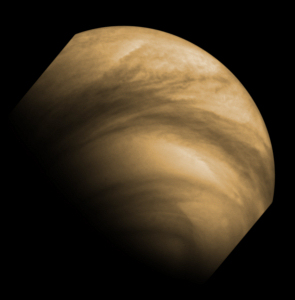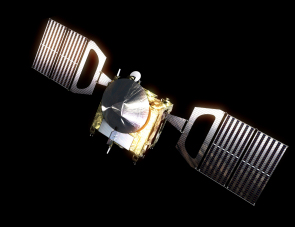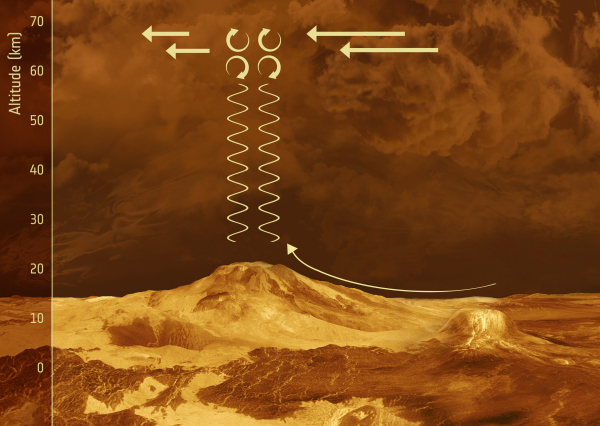What lies beneath: Venus' surface revealed through the clouds
18 July 2016
Using observations from ESA's Venus Express satellite, scientists have shown for the first time how weather patterns seen in Venus' thick cloud layers are directly linked to the topography of the surface below. Rather than acting as a barrier to our observations, Venus' clouds may offer insight into what lies beneath.Venus is famously hot, due to an extreme greenhouse effect which heats its surface to temperatures as high as 450 degrees Celsius. The climate at the surface is oppressive; as well as being hot, the surface environment is dimly lit, due to a thick blanket of cloud which completely envelops the planet. Ground-level winds are slow, pushing their way across the planet at painstaking speeds of about 1 metre per second – no faster than a gentle stroll.
However, that is not what we see when we observe our sister planet from above. Instead, we spy a smooth, bright covering of cloud. This cloud forms a 20-km-thick layer that sits between 50 and 70 km above the surface and is thus far colder than below, with typical temperatures of about -70 degrees Celsius – similar to temperatures found at the cloud-tops of Earth. The upper cloud layer also hosts more extreme weather, with winds that blow hundreds of times faster than those on the surface (and faster than Venus itself rotates, a phenomenon dubbed 'super-rotation').
While these clouds have traditionally blocked our view of Venus' surface, meaning we can only peer beneath using radar or infrared light, they may actually hold the key to exploring some of Venus' secrets. Scientists suspected the weather patterns rippling across the cloud-tops to be influenced by the topography of the terrain below. They have found hints of this in the past, but did not have a complete picture of how this may work – until now.
 |
| Venus cloud tops. Credit: ESA/MPS/DLR/IDA |
Scientists using observations from ESA's Venus Express satellite have now greatly improved our climate map of Venus by exploring three aspects of the planet's cloudy weather: how quickly winds on Venus circulate, how much water is locked up within the clouds, and how bright these clouds are across the spectrum (specifically in ultraviolet light).
"Our results showed that all of these aspects – the winds, the water content, and the cloud composition – are somehow connected to the properties of Venus' surface itself," says Jean-Loup Bertaux of LATMOS (Laboratoire Atmosphères, Milieux, Observations Spatiales) near Versailles, France, and lead author of the new Venus Express study. "We used observations from Venus Express spanning a period of six years, from 2006 to 2012, which allowed us to study the planet's longer-term weather patterns."
Although Venus is very dry by Earth standards, its atmosphere does contain some water in the form of vapour, particularly beneath its cloud layer. Bertaux and colleagues studied Venus' cloud-tops in the infrared part of the spectrum, allowing them to pick up on the absorption of sunlight by water vapour and detect how much was present in each location at cloud-top level (70 km altitude).
They found one particular area of cloud, near Venus' equator, to be hoarding more water vapour than its surroundings. This 'damp' region was located just above a 4500-metre-altitude mountain range named Aphrodite Terra. This phenomenon appears to be caused by water-rich air from the lower atmosphere being forced upwards above the Aphrodite Terra mountains, leading researchers to nickname this feature the 'fountain of Aphrodite'.
"This 'fountain' was locked up within a swirl of clouds that were flowing downstream, moving from east to west across Venus," says co-author Wojciech Markiewicz of the Max-Planck Institute for Solar System Research in Göttingen, Germany. "Our first question was, 'Why?' Why is all this water locked up in this one spot?"
In parallel, the scientists used Venus Express to observe the clouds in ultraviolet light, and to track their speeds. They found the clouds downstream of the 'fountain' to reflect less ultraviolet light than elsewhere, and the winds above the mountainous Aphrodite Terra region to be some 18 per cent slower than in surrounding regions.
All three of these factors can be explained by one single mechanism caused by Venus' thick atmosphere, propose Bertaux and colleagues.
"When winds push their way slowly across the mountainous slopes on the surface they generate something known as gravity waves," adds Bertaux. "Despite the name, these have nothing to do with gravitational waves, which are ripples in space-time – instead, gravity waves are an atmospheric phenomenon we often see in mountainous parts of Earth's surface. Crudely speaking, they form when air ripples over bumpy surfaces. The waves then propagate vertically upwards, growing larger and larger in amplitude until they break just below the cloud-top, like sea waves on a shoreline."
As the waves break, they push back against the fast-moving high-altitude winds and slow them down, meaning that winds above Venus' Aphrodite highlands are persistently slower than elsewhere.
However, these winds re-accelerate to their usual speeds downstream of Aphrodite Terra – and this motion acts as an air pump. The wind circulation creates an upwards motion in Venus' atmosphere that carries water-rich air and ultraviolet-dark material up from below the cloud-tops, bringing it to the surface of the cloud layer and creating both the observed 'fountain' and an extended downwind plume of vapour.
 |
| Venus Express spacecraft. Credit: ESA |
"We've known for decades that Venus' atmosphere contains a mysterious ultraviolet absorber, but we still don't know its identity," says Bertaux. "This finding helps us understand a bit more about it and its behaviour – for example, that it's produced beneath the cloud-tops, and that ultraviolet-dark material is forced upwards through Venus' cloud-tops by wind circulation."
Scientists already suspected that there were ascending motions in Venus' atmosphere all along the equator, caused by the higher levels of solar heating. This finding reveals that the amount of water and ultraviolet-dark material found in Venus' clouds is also strongly enhanced at particular places around the planet's equator. "This is caused by the mountains way down on Venus' surface, which trigger rising waves and circulating winds that dredge up material from below," says Markiewicz.
As well as helping us understand more about Venus, the finding that surface topography can significantly affect atmospheric circulation has consequences for our understanding of planetary super-rotation, and of climate in general.
"This certainly challenges our current General Circulation Models," says Håkan Svedhem, ESA Project Scientist for Venus Express. "While our models do acknowledge a connection between topography and climate, they don't usually produce persistent weather patterns connected to topographical surface features. This is the first time that this connection has been shown clearly on Venus – it's a major result."
Venus Express was in operation at Venus from 2006 until 2014, when its mission concluded and the spacecraft began its descent through Venus' atmosphere.
The study by Bertaux and colleagues made use of several years of Venus Express observations gathered by the Venus Monitoring Camera (VMC) – to explore the wind speeds and ultraviolet brightness of the clouds – and by the SPICAV spectrometer (Spectroscopy for Investigation of Characteristics of the Atmosphere of Venus) – to study the amount of water vapour contained within the clouds.
"This research wouldn't have been possible without Venus Express' reliable and long-term monitoring of the planet across multiple parts of the spectrum. The data used in this study were collected over many years," adds Svedhem. "Crucially, knowing more about Venus' circulation patterns may help us to constrain the identity of the planet's mysterious ultraviolet absorber, so we can understand more about the planet's atmosphere and climate as a whole."
Notes for editors
"Influence of Venus topography on the zonal wind and UV albedo at cloud top level: the role of stationary gravity waves", by J.-L. Bertaux et al., is published in the Journal of Geophysical Research: Planets. doi: 10.1002/2015JE004958
The study is based on data from Venus Express' VMC (Venus Monitoring Camera) and SPICAV spectrometer (Spectroscopy for Investigation of Characteristics of the Atmosphere of Venus).
ESA's Venus Express was launched in 2005, arrived at Venus in 2006, and spent eight years exploring the planet from orbit. The mission ended in December 2014 after the spacecraft ran out of orbit-raising propellant and entered the atmosphere. Some science highlights from Venus Express can be found here.
For further information, please contact:
Jean-Loup Bertaux
Université de Versailles Saint-Quentin-en-Yvelines
LATMOS/INSU/CNRS, France
Email: jean-loup.bertaux![]() latmos.ipsl.fr
latmos.ipsl.fr
Phone: +33-6-1441-3890
Wojciech Markiewicz
Max-Planck Institute for Solar System Research
Göttingen, Germany
Email: markiewicz![]() mps.mpg.de
mps.mpg.de
Håkan Svedhem
Venus Express Project Scientist
Directorate of Science
European Space Agency
Email: Hakan.Svedhem![]() esa.int
esa.int
Phone: +31-71-565-3370




